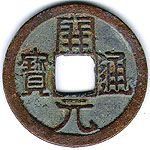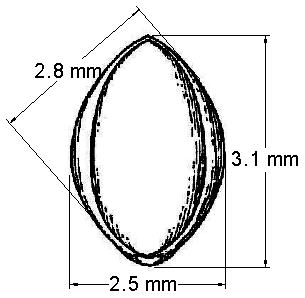Ancient Measurement Systems
The technical data given in the Sung Shih
is deceptively accurate. But be careful - Chinese measures are a little
different!
The Chinese Foot
If you know a little about the chaotic length measuring systems of
Medieval Europe, you will be surprised to hear that the ancient chinese
system survived from the time of the Three Dynasties (well before 220
BC) to the present day and is now even "metric"!.
The basic unit is not the lower extremity of some deceased ruler, but
the humble seed of the millet (Panicum milliaceum L.). The "standard" grain
(fen),
attributed to the mean of the harvest of Shangdang in prefecture Shanhsi, is not spherical, but has
a width (horizontal grain) of
0.81 times its height (vertical grain).
Ten grains make one inch (cun), and ten
inch are called one foot (chi). To make
things a little more interesting, different dynasties used the
horizontal or vertical grain as starting point, so we end up with horizontal and vertical feet.
The "standard" grain
(fen),
attributed to the mean of the harvest of Shangdang in prefecture Shanhsi, is not spherical, but has
a width (horizontal grain) of
0.81 times its height (vertical grain).
Ten grains make one inch (cun), and ten
inch are called one foot (chi). To make
things a little more interesting, different dynasties used the
horizontal or vertical grain as starting point, so we end up with horizontal and vertical feet.
Of course it would be absurd to base our reconstruction on modern
crops. Luckily we have a preserved document (the Yu-Ku-Chai Ch'in),
concerned with musical instrument construction and therefore "correct"
string dimensions, which links the millet system to certain coins,
which in turn have survived dimensionally intact. For example the K'ai Yuan copper
coin ,
minted for three hundred years from 618 AD on, is defined as having a
diameter of ten horizontal grains, and consistently has a diameter of
25 mm today - if found in mint condition. The "standard" grain can
therefore be dimensioned as shown below.
,
minted for three hundred years from 618 AD on, is defined as having a
diameter of ten horizontal grains, and consistently has a diameter of
25 mm today - if found in mint condition. The "standard" grain can
therefore be dimensioned as shown below.

From all this we can derive the following Conversion Table:
Dynasty
|
from
- to
|
base
|
grain
|
inch
|
foot
|
Hsia
|
2000 BC -
1520 BC
|
horizontal
|
2.5 mm
|
25 mm
|
250 mm
|
Shang
|
1520 BC -
1030 BC
|
vertical
|
3.09 mm
|
30.9 mm
|
309 mm
|
Chou
|
1030 BC -
221 BC
|
|
2.0 mm
|
20 mm
|
200 mm
|
Han
|
202 BC - 220
AD
|
slanted
|
2.78 mm
|
27.8 mm
|
278 mm
|
| Tang |
618 AD - 906
AD |
horizontal |
2.5 mm |
25 mm |
250 mm |
Sung
|
960 AD -
1279 AD
|
vertical |
3.09 mm |
30.9 mm |
309 mm |
SI
|
Today |
1/300 m
|
3.33 mm
|
33.3 mm
|
333 mm
|
Sources: Yu-Ku-Chai Ch'in-Pu,
English translation found at http://www.cs.pdx.edu/~jrb/chin/
 The "standard" grain
(fen),
attributed to the mean of the harvest of Shangdang in prefecture Shanhsi, is not spherical, but has
a width (horizontal grain) of
0.81 times its height (vertical grain).
Ten grains make one inch (cun), and ten
inch are called one foot (chi). To make
things a little more interesting, different dynasties used the
horizontal or vertical grain as starting point, so we end up with horizontal and vertical feet.
The "standard" grain
(fen),
attributed to the mean of the harvest of Shangdang in prefecture Shanhsi, is not spherical, but has
a width (horizontal grain) of
0.81 times its height (vertical grain).
Ten grains make one inch (cun), and ten
inch are called one foot (chi). To make
things a little more interesting, different dynasties used the
horizontal or vertical grain as starting point, so we end up with horizontal and vertical feet. ,
minted for three hundred years from 618 AD on, is defined as having a
diameter of ten horizontal grains, and consistently has a diameter of
25 mm today - if found in mint condition. The "standard" grain can
therefore be dimensioned as shown below.
,
minted for three hundred years from 618 AD on, is defined as having a
diameter of ten horizontal grains, and consistently has a diameter of
25 mm today - if found in mint condition. The "standard" grain can
therefore be dimensioned as shown below.